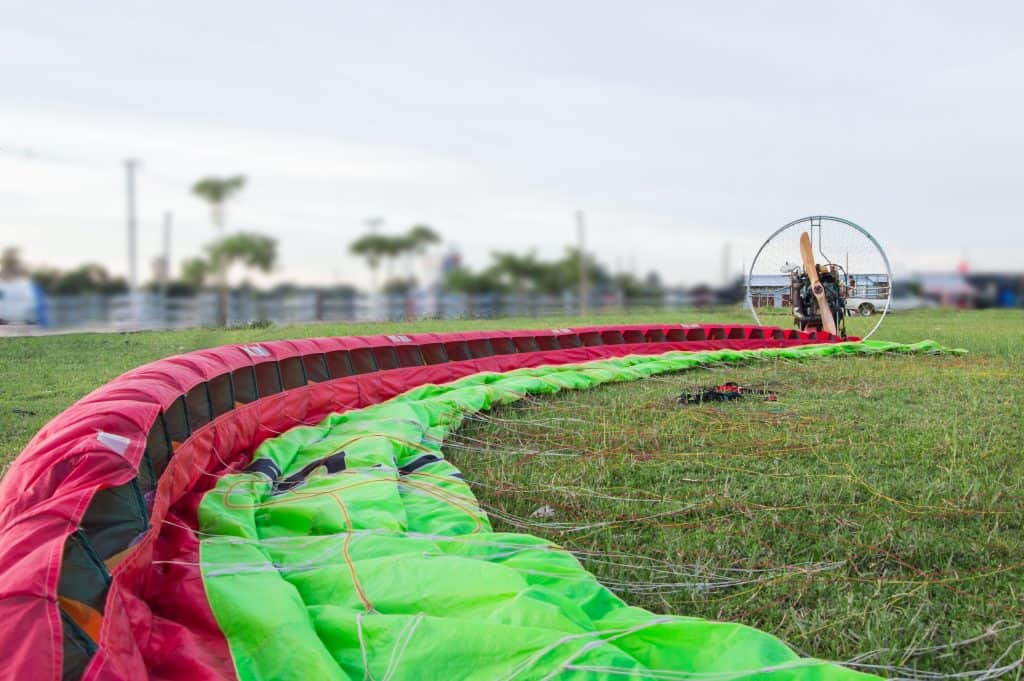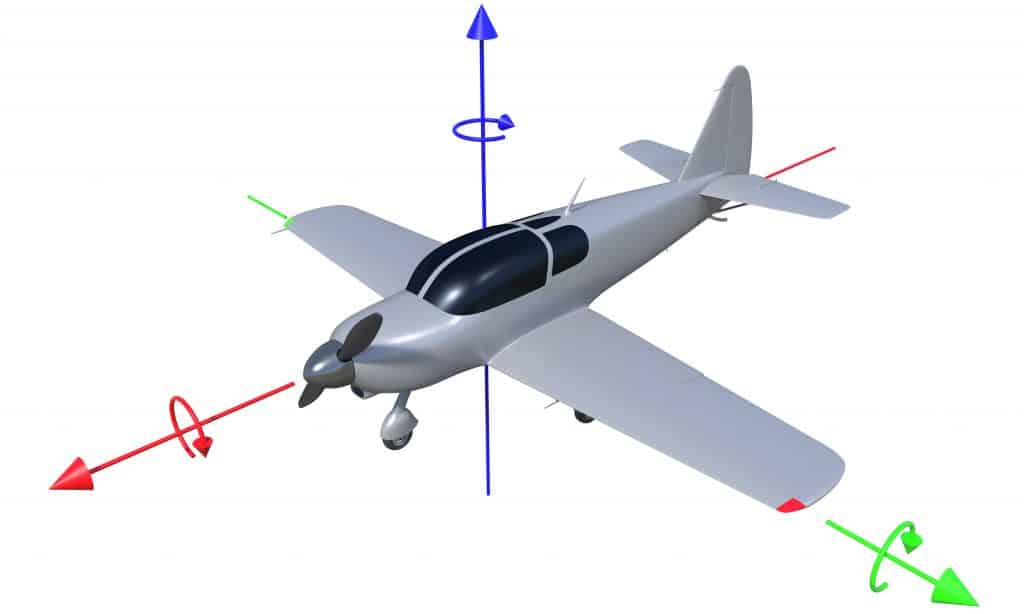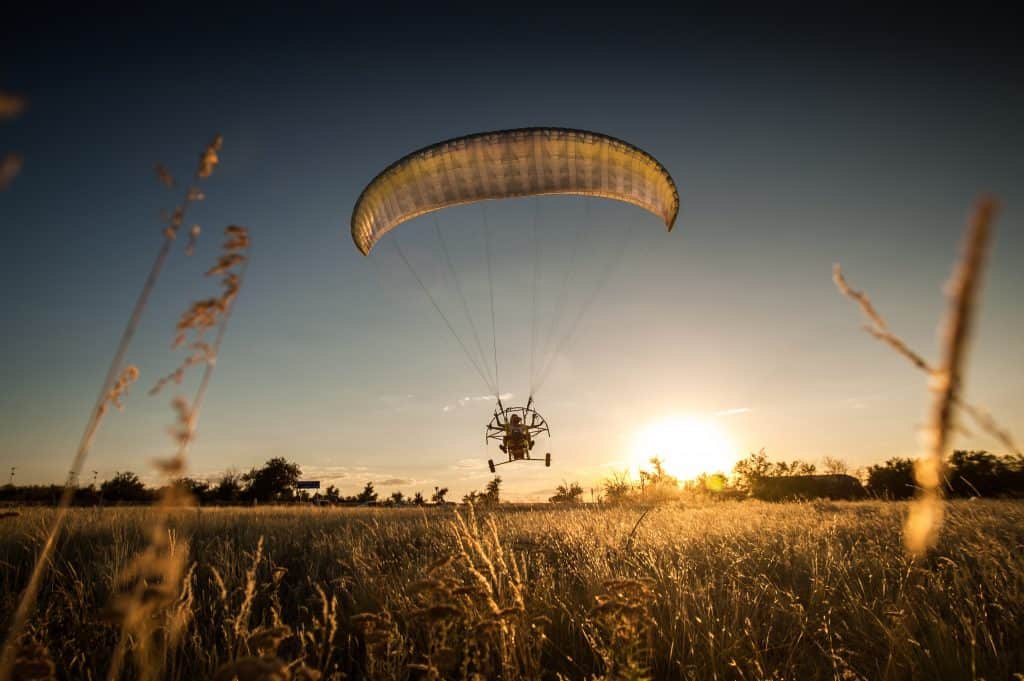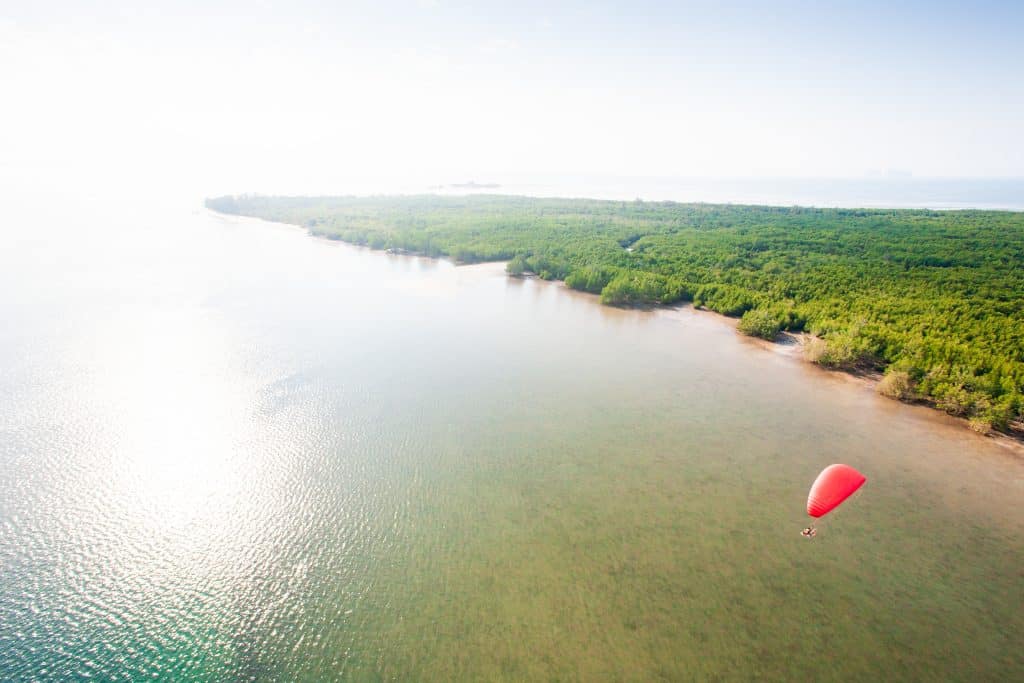
Every paramotor pilot fears a wing collapse. A collapsed wing can happen unexpectedly and, depending on your altitude, can be a life or death situation. Just how often do paramotor wing collapses happen, and what’s the cause?
How often do paramotor wings collapse, and what causes it? A paramotor wing collapse is incredibly rare. Competent pilots flying in safe conditions can fly for thousands of hours and never experience a wing collapse. Flying in unfavorable conditions or bad decision making can cause it more often. The typical cause of a paramotor wing collapse are thermals or rough winds.
If you want to minimize the chance of a wing collapse, don’t fly in thermals or turbulence and avoid low altitude flight.
Let’s talk about the process of how wings can collapse and how to prevent it. Then we’ll discuss what to do in the event of a wing collapse and take a close look at some safe paramotor wings on the market today.
How a Paramotor Wing Collapses
To understand what the wing is doing, it helps to know a few paramotoring terms. Here are the basic need-to-knows:
Angle of Attack
Put very simply, the angle of attack is the angle at which the leading edge of the wing meets the wind.
For clarities sake, imagine the shape here is the paramotoring wing.

The angle of attack is important because when the angle of attack dips below the flow direction, a wing collapse is likely to occur.
Yaw
Yaw is a type of rotation that an aircraft can experience. Yaw is important in paramotoring, as an inappropriately timed or poorly executed yaw input can cause wind pressure on the upper side of the wing.

Knowing this, we can understand the potential causes of wing collapses.
The Potential Causes Of Wing Collapse
Pitching Up And Downdrafts
The angle of attack goes too low because the paramotor is pitching up locally (or, equivalently, there is a local downdraft).
This happens when the whole paramotor is going up, or the wind presses down on top of the paramotor. It can cause the leading edge of the wing to fold down, resulting in a collapse.
The solution to this kind of collapse is to prevent the glider from pitching up suddenly and to avoid encountering local downdrafts.
You can do both of these things, to some extent, by pitch control. However, in order to avoid local downdrafts, it requires some anticipation of local air movements.
Prevent the glider from pitching up suddenly, and avoid encountering local downdrafts.
Yaw
A yaw motion can cause one of the tips of the wing to pull ahead, in front of the other, so that the wing sideslips.
The new angle of attack on the leading tip (the one that is now ahead) causes it to dip down lower than the rest of the wing. This generally causes a collapse where the tip folds inwards. In some cases, the tip can go floppy before it rolls or folds in.
In other words, the collapse here starts at the tip of the wing rather than along the length of the leading edge.
The solution to this kind of collapse is controlling the yaw of your paramotor. If the tip is collapsing while you’re thermalling, then it is most likely that you are being too aggressive and frequent with your weight-shift relative to the times you are braking.
Each time that you try to weight-shift, the side of the wing that is going down in the weight-shift experiences air coming at it from below. This causes it to generate some thrust forwards, while the wing that is going up experiences an equal increase in drag.
A brief stab of the brake is required to balance this yaw effect of weight-shifting.
On some wings, a brief stab of the brake at the onset of weight shifting, perhaps even a bit before weight-shifting will get the wing to start yawing in the opposite direction.
As you weight-shift, the yaw effect from the weight-shift will counter the yaw effect from the break. Time it right, and you’ll end up with a nicely balanced maneuver leaving you with minimal energy loss, and a non-collapsed wing.
Thermals
Typically, if your wing collapses while flying the most likely cause is that you have just found the outside of the thermal with your wing tip. With the warm air of the thermal pushing you up, and part of your wing outside of the thermal, the pressure caused from the air outside the thermal pressing down on the one side of the wing while the rest of the wing is pulling it upwards causes it to collapse.
You may be using too much inside brake.
Excessive Braking
Another reason that your wing can collapse is the use of too much inside brake. When you use the brake on the side of your wing that’s closest to the center of a thermal, it can cause that side of the wing to gain lift faster than the other. With one side being lifted up more quickly than the other, a wing collapse can occur.
Turbulence
There is turbulence out there that will collapse any wing. Fortunately, if you encounter this sort of air at a high enough altitude, a paramotor will recover.
Next, let’s talk a bit more about the different types of collapse and what to do about them.
Types of Wing Collapses

Not all wing collapses are created equal. Different types of wing collapse have distinct causes, ways to avoid them, and solutions.
Parachutal Stall
New pilots are especially susceptible to parachutal stall, as they tend to pump their breaks and go slowly to feel safe.
Pilots who constantly and purposelessly pull their breaks are at risk of stalling their wing. The stalling of your wing could also be caused by flying too slowly in thermals, or flying in strong, gusty conditions. When you stall your wing, it’s called parachutal stall.
If this happens close to the ground, there is little chance of a clear and safe recovery. As the breaks are released, the wing will dive forwards to regain airspeed, effectively swinging the pilot in a pivot around the wing. If you are too close to the ground, the stall could swing you straight into the ground.
However, if the breaks aren’t released, the wing could fully collapse, or the paramotor could start spinning.
To avoid this, you should never pull both brakes without reason, your wing needs the airspeed to keep flying. You should also avoid flying in strong thermals and windy/gusty conditions, as this can cause extremely high angles of attack.
Asymmetric Collapse
An asymmetric collapse is where one side of the wing collapses and tucks in.
A paramotor has to fly with its wings in symmetrical balance. If you were to draw a line through the center of the paramotor wing, both sides of the line should be the same. If they differ somehow, with one side being tucked in, that’s a problem.
A tucked wing causes drag, causing a turn, which can cause a dive. It’s possible to weight shift to steer out of this, but it requires some ridiculously fine-tuned break input.
If you break too hard, you could stall the wing, but you also need to be careful about the wing entering a spiral dive from the asymmetry.
Frontal Collapse
A frontal collapse occurs when the leading edge of the wing is pushed/tucked under the rest of the wing. The result of this is an immediate loss of lift for the paramotor.
As the pilot’s momentum continues forward, the wing will yank back because of the increased drag from the tucked wing. This puts more tension on the rear lines and increases the angle of attack.
This will cause the wing to reinflate but will need airspeed, so will enter a steep dive.
Wings are specifically made to recover quickly from a frontal collapse. To help this process, a short, sharp pump on the breaks should be applied as soon as the tuck happens. this will force trapped air inside the wing from the rear of the wing to the leading edge, helping to untuck the wing.
If the first quick pump of the breaks doesn’t re-inflate the wing, wait until you swing back underneath the wing before pulling strongly on the brakes for about two seconds.
Frontal collapses could happen when exiting the thermal winds, flying in strong wind turbulence, or flying downwind of obstacles that could affect wind flow. Be careful not to break too hard and cause a stall when trying to escape a frontal collapse.
What to Do if Your Wing Collapses
Paramotor wings are specially designed to revert back to their “non-collapsed” state after stalling. Many paramotorists say that wings collapsing is a good thing.
Wing collapses are an important and necessary part of the maintaining of the stability of paramotors. When any aircraft experience a change in their angle of attack, the aircraft will need to be able to try to return to a state of stability on its own.
Wing collapsing may be a good thing in paramotoring.
Unless they have a computer controlling them, this return of stability needs to be put in place by design and automatically engaged, and not require pilot input.
Airplanes have tails to help keep them straightened out, and hang gliders have luff in their lines, washout in their tips, and swept wings. Even hot air balloons have this natural inclination to stay upright from the heat in the balloon and the weight of the basket constantly exerting a force onto the balloon to keep it stable.
Paramotors, however, are unique. They don’t have the tail of an airplane, or the swept wings of a hang glider, or a balloon to keep it upright at all times.
This is where the design of a paramotor and its wing collapse is important.
When a paramotor wing enters into an angle of attack where the wind is pressing up against the top of the paramotor, it will collapse. Though this is a scary process for many pilots, it’s better than the alternative.
In a collapse, the crumpled wing will slow down from the drag of the paramotor’s momentum, and return more or less over the pilots head. It will return to its correct shape, and then the paramotor is stable.
If the wing was prevented from collapsing in some way or another, the wing would keep its shape and keep surging forward until the pilot was no longer suspended by the lines, but instead was falling towards the wing.
If your wing collapses, don’t freak out.
The pilot could potentially fall into the wing and plummet down to the ground wrapped in their wing. If the pilot were to miss the wing, the shock of the lines suddenly being yanked between the force of the pilot and the wing could cause them to break.
So, if your wing collapses, don’t freak out. If you are at a high enough altitude, the problem should fix itself in time. This is supposed to happen and is in the design of the paramotor wing to fix itself.
There are ways to help the process along though and make it so that a wing collapse is gone through more smoothly.
One course you can take to help you with this is the SIV course. It stands for simulation d’incident en vol; which, means incident simulation.
One of these SIV courses is hosted by eagleparagliding.com, and the course consists of professionals teaching you how to do the following safely:
- Asymmetric Tucks
- Full Frontal Tucks
- B Line Stalls
- Spirals
- Pitch Control (dolphining)
- Full Stalls
- Spins
- Wingovers
- Acro
- Frontal Collapse
- Asymmetric Collapse
- Spirals
- Full Spirals
You can use these along with several other dangerous aerial acrobatic manuevers.
Taking an SIV course will help you to have the proper training to know what to do automatically should you ever have a wing collapse on you.
Especially when getting into aerial acrobatics, the instructors in an SIV course can talk you through each maneuver, and you can learn how to avoid and recover from collapses in a safe environment.
Preventing Paramotor Wing Collapse Disasters

To help yourself stay safe, you should take the following advice:
#1 Fly in Windless Conditions
Paramotors are capable of flying in zero wind conditions. Take advantage of that. The random gusts of wind that come with some weather conditions are the main cause of wing collapses.
One of the best ways to stay safe while flying is to avoid wind gusts that could tuck your wing.
Gusts of wind that are 5 mph above the average wind speed that day are unpleasant to fly in. Average wind speeds should range from 0 mph to 12 mph for a safe and pleasant flight.
#2 Have a Reserve Chute
Every paramotorist should have a reserve parachute in case of emergency. Some models have spare chutes that come with them, but there are chutes that can be bought online as well.
#3 Fly in the Morning and Evening
Thermals are another thing that can cause wing collapses. The difference in air temperature, between inside and outside of the thermal, causes the air inside the thermal to rise. Paragliders can use this to ascend in elevation, but it’s potentially dangerous.
Flying in the mornings before thermals have formed, and in the evenings after thermals have dissipated are good times to avoid them.
#4 Fly With Safety-Rated Wings
There are many third-party companies that rate paramotors on safety. For the safest paramotor/paragliding wings, look at this rating chart.
| Pilot | Beginner | Intermediate | Advanced | Expert |
| EN | A | B | C | D |
| LFT | 1 | 1-2 | 2 | 2-3 |
When looking to purchase a paramotor wing, look for one of the ratings on this chart, and decide for yourself whether or not it meets the safety standards you’ve set for yourself.
#5 Fly at Higher Altitudes
The last piece of advice I can give is to fly at higher altitudes. In lower altitudes, if anything does go wrong, there is very little time to fix the problem.
At higher altitudes, there is more time to analyze the individual situation and find a way out of it.
At lower altitudes, you may not even have a chance to react before disaster strikes. Do your best to stay safe while paramotoring, it’ll pay off when you least expect it, and most need it.
Related Questions
Can paramotors fly over water? Paramotors can fly over water. However, this is not recommended. You don’t want to have that fan strapped to your back dragging you down in the middle of a lake.
How much does a paramotor cost? Articles that talk about equipment may have the price of the paramotor and the wing listed separately. So, first of all, if you are comparing information from different sources, make sure you’re comparing like with like.
Currently, in the summer of 2020, the majority of new paramotors are in the $6,000 and $10,00 price range. Meanwhile, most wings go for between $2,500 and $4,000.
